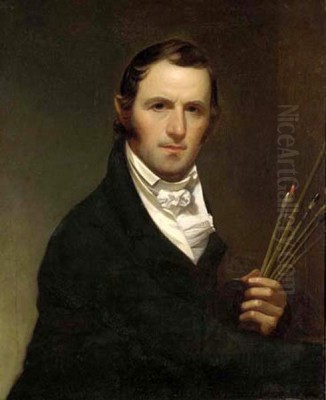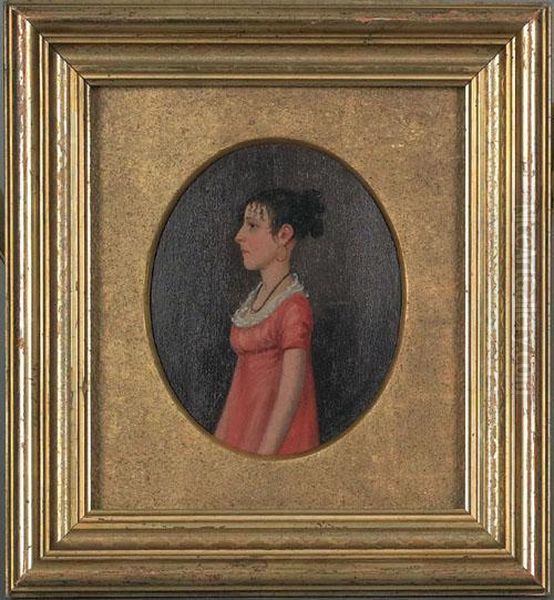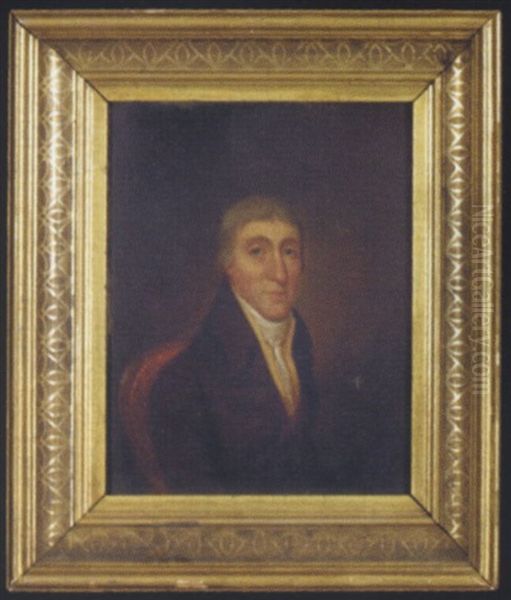
Jacob Eichholtz stands as a significant figure in the nascent art scene of the early American Republic. Born in Lancaster, Pennsylvania, in 1776, a year that heralded the birth of a new nation, Eichholtz's life and career would mirror the aspirations and burgeoning identity of the United States. Though he began his professional life in a more utilitarian trade, his innate talent and passion for art eventually led him to become one of the most prolific and respected portrait painters of his era, particularly in Pennsylvania and Maryland. His journey from a craftsman to a fine artist, largely self-taught yet refined by encounters with leading painters of his day, offers a compelling narrative of artistic development in a young country still forging its cultural landscape.
From Coppersmith to Canvas: An Unconventional Beginning
Jacob Eichholtz's entry into the world of art was not preordained by formal training or familial artistic lineage. He was initially apprenticed as a coppersmith and tinsmith in his native Lancaster. This practical trade, while providing a livelihood, could not entirely suppress his artistic inclinations. The precise moment of his full commitment to art is often cited around 1801, when he decided to dedicate himself to painting. This was a bold move in a society where art was still considered a luxury by many, and a sustainable career as a painter was far from guaranteed, especially outside major cultural centers like Boston or Philadelphia.

His early efforts were characterized by the determination of a self-taught artist. He diligently honed his skills, likely by studying available prints and perhaps the occasional painting that found its way to Lancaster. The turning point in his early development came in 1808 with his encounter with Thomas Sully (1783-1872). Sully, an English-born artist who would become one of America's foremost portraitists, recognized Eichholtz's potential. He offered Eichholtz guidance and even the use of his painting room. This interaction, though perhaps brief, provided Eichholtz with invaluable insights into technique, materials, and the professional practice of portraiture. Sully's own style, known for its elegance and romantic flair, influenced by British masters like Sir Thomas Lawrence (1769-1830), would have offered a sophisticated model for the aspiring Lancaster painter.
The Influence of Masters and the Forging of a Style
Eichholtz's ambition and desire for improvement led him to seek out other established artists. A pivotal moment was his visit to Boston in 1811, where he had the opportunity to meet the preeminent American portraitist Gilbert Stuart (1755-1828). Stuart, famed for his iconic portraits of George Washington and other leading figures of the Revolutionary and Federal periods, was known for his fluid brushwork and ability to capture the character of his sitters. Though Eichholtz's time with Stuart was reportedly short, the experience was profoundly impactful. Stuart's advice, particularly regarding flesh tones and capturing a likeness, would have been instrumental. Eichholtz himself acknowledged Stuart's influence, and it's visible in the increased sophistication and confidence in his subsequent work.
Despite these important encounters, Eichholtz largely remained a "native genius," as some contemporaries described him. He absorbed lessons from Sully and Stuart, but his style retained a distinct character. His portraits are often described as strong and linear, with a meticulous attention to detail, especially in the rendering of fabrics, lace, and the specific features of his sitters. This meticulousness might, in part, stem from his earlier training as a craftsman, where precision was paramount. His approach was generally more direct and less idealized than Sully's, and perhaps less psychologically penetrating than Stuart's best work, but it possessed an honesty and solidity that appealed to his clientele. He developed a remarkable ability to capture a strong likeness, a crucial skill for a portraitist reliant on commissions.
His palette was often rich, and he demonstrated a good understanding of light and shadow to model forms. While he might not have achieved the painterly bravura of Stuart or the romantic elegance of Sully, Eichholtz's work had a distinct American flavor – straightforward, unpretentious, and grounded in a tangible reality. This resonated with the rising merchant class, professionals, and civic leaders who formed the bulk of his patrons.
A Prolific Career: Documenting the Faces of a New Nation

Between roughly 1810 and his death in 1842, Jacob Eichholtz was exceptionally prolific, creating over 850 portraits. His primary centers of activity were Lancaster, Philadelphia, and Baltimore, though he also undertook commissions in other parts of Pennsylvania and Maryland. Philadelphia, then the largest city in the United States and a major cultural hub, provided him with significant opportunities. He moved there for a period, further immersing himself in its artistic milieu.
His sitters were a veritable who's who of the prominent families and individuals of the region. These included lawyers, merchants, clergymen, politicians, and their families. Among his most famous subjects were Chief Justice John Marshall (1755-1835), a foundational figure in American jurisprudence, and Nicholas Biddle (1786-1844), the influential president of the Second Bank of the United States. Portraits of such distinguished individuals not only cemented Eichholtz's reputation but also provide invaluable historical records of the key players in early 19th-century America.
His portrait of John Marshall, for instance, conveys a sense of gravitas and intellectual power, befitting the Chief Justice. The depiction of Nicholas Biddle captures the confidence and authority of a leading financier. Beyond these well-known figures, Eichholtz painted numerous portraits of less nationally prominent but locally important individuals, effectively creating a visual archive of the society in which he lived and worked. His female portraits, such as Julianna Hazlhurst, often showcase his skill in rendering elaborate costumes and conveying a sense of genteel refinement.
While portraiture was his mainstay, Eichholtz also ventured into other genres, though less frequently. He painted a few landscapes, such as Cape Henlopen, which was reportedly a copy or adaptation of a work by the marine painter Thomas Birch (1779-1851). He also produced some historical and religious paintings, demonstrating a broader artistic interest, though these form a small fraction of his overall output.
The Artistic Milieu: Contemporaries and Context
Eichholtz operated within a dynamic and evolving American art world. In Philadelphia, he would have been aware of the legacy of Charles Willson Peale (1741-1827), a towering figure who was not only a prolific portraitist but also a naturalist, inventor, and founder of the Peale Museum and the Pennsylvania Academy of the Fine Arts (PAFA). Peale's sons, including Rembrandt Peale (1778-1860) and Raphaelle Peale (1774-1825), were also significant artists. Rembrandt Peale was a direct contemporary and competitor in portraiture, known for his polished style and "porthole" portraits of Washington.
Other notable portraitists active during Eichholtz's career included John Wesley Jarvis (c. 1780-1840), a popular and flamboyant painter working primarily in New York but also undertaking itinerant work; Chester Harding (1792-1866), another largely self-taught artist who achieved considerable success; and Samuel F.B. Morse (1791-1872), who, before gaining fame as the inventor of the telegraph, was a highly skilled portrait painter and a founder of the National Academy of Design. The work of John Neagle (1796-1865), a Philadelphia-based artist and son-in-law of Thomas Sully, also overlapped with Eichholtz's later career. Neagle was known for his vigorous and characterful portraits, such as the famous Pat Lyon at the Forge.
The influence of earlier American masters like John Singleton Copley (1738-1815), though Copley had long since moved to England, was still felt through his powerful colonial portraits. Similarly, Benjamin West (1738-1820), a Pennsylvania native who became President of the Royal Academy in London, served as a mentor to a generation of American artists who traveled abroad, including Stuart and Sully. While Eichholtz did not study abroad, the artistic currents flowing back from Europe through these artists undoubtedly shaped the environment in which he worked.
Eichholtz's success can be attributed to his ability to provide his patrons with what they desired: accurate likenesses that conveyed their status and respectability, rendered with a competent and increasingly sophisticated technique. He managed to carve out a successful niche, particularly valued in communities like Lancaster, where access to highly trained artists was limited. He was, in many ways, the quintessential regional master, deeply connected to his community.
Participation in Artistic Life and Institutions
Jacob Eichholtz was not an isolated figure. He actively participated in the burgeoning artistic life of his time. His connection with the Pennsylvania Academy of the Fine Arts (PAFA) in Philadelphia was significant. Founded in 1805, PAFA was one of the earliest art institutions in America, dedicated to instruction and exhibition. Eichholtz began exhibiting his work at PAFA's annual exhibitions in 1811, following his visit to Boston and his encounter with Gilbert Stuart. He continued to show his paintings there regularly for much of his career, almost until his death. This participation provided him with visibility, critical feedback, and a connection to the broader artistic community.
In Boston, during his 1811 visit, he also reportedly joined the Society of Artists, indicating his desire to be recognized and integrated within professional artistic circles. Locally, his work became a source of pride. Exhibitions of his paintings were held at institutions such as the Lancaster County Historical Society, the Phillips Museum of Art at Franklin & Marshall College (which holds a significant collection of his work), and the Lancaster Heritage Center Museum of Lancaster County (now part of LancasterHistory). These posthumous and contemporary acknowledgments underscore his importance to his home region. His involvement with the "Lancaster Countyers' Association" for exhibitions further highlights his local prominence.
These affiliations demonstrate Eichholtz's engagement with the institutional frameworks that were slowly developing to support and promote art in America. For an artist largely based outside the primary metropolitan centers for part of his career, these connections were vital for maintaining a professional profile and reaching a wider audience.
Personal Life and Character
Details about Eichholtz's personal life suggest a man of diligence and stability. He was married twice. His first wife was Catharine Hatz Michael, with whom he had four children. After her death, he married Catharine Trissler, with whom he had one child. A stable family life likely provided a supportive backdrop for his demanding career as a prolific painter.
Anecdotes from his life, such as his decisive shift from being a coppersmith to a painter, illustrate his determination and passion for art. The story of Thomas Sully initially encouraging him, even if Sully later offered some critiques that might have seemed harsh, points to the collegial yet competitive nature of the art world. Eichholtz's ability to produce such a vast number of portraits while maintaining a consistent quality speaks to his strong work ethic and business acumen. He managed his career effectively, securing commissions and satisfying a diverse clientele, which led to considerable financial success and high regard among his peers.
The preservation of his works, sometimes through serendipitous discoveries like the portrait of John Johnson being found and returned to the family, adds a touch of romance to his legacy and highlights the enduring value placed on his art by subsequent generations.
Later Years and Enduring Legacy
Jacob Eichholtz continued to paint actively throughout the 1830s and into the early 1840s. He remained based primarily in Lancaster in his later years, though his reputation extended well beyond his hometown. He passed away in Lancaster in 1842, leaving behind a rich legacy of several hundred portraits that serve as a visual chronicle of his time.
His death marked the end of a significant chapter in early American art. He was one of the last prominent American painters whose formative years predated the widespread availability of formal art academies in the United States and the ease of travel for European study, although younger artists like George P.A. Healy (1813-1894) or Daniel Huntington (1816-1906) were already benefiting from such opportunities.
Eichholtz's legacy is multifaceted. Firstly, he is celebrated as a key regional painter, particularly for Lancaster and central Pennsylvania, where he was the preeminent artist for decades. His works are prized by historical societies and museums in the area, offering a window into the local elite of the early 19th century. Secondly, on a national level, he is recognized as an important contributor to the broader school of early American portraiture. His paintings of figures like Marshall and Biddle are significant historical documents. Thirdly, his career exemplifies the path of a "native genius" – an artist who, through talent, hard work, and strategic learning from available masters, achieved remarkable success without the benefit of extensive academic training abroad, a path also trod by artists like Matthew Harris Jouett (1788-1827) in Kentucky.
His style, while perhaps not as innovative or influential as that of Stuart or Sully, possessed a distinct character that captured the spirit of his sitters and their era. His meticulousness, strong sense of likeness, and the sheer volume of his output make him an indispensable figure for understanding the social and cultural fabric of the Middle Atlantic states in the early to mid-19th century. His paintings continue to be studied for their artistic merit, their historical content, and what they reveal about the aspirations and values of early American society. Jacob Eichholtz, the coppersmith who became a painter, truly left an indelible mark on the canvas of American art history.